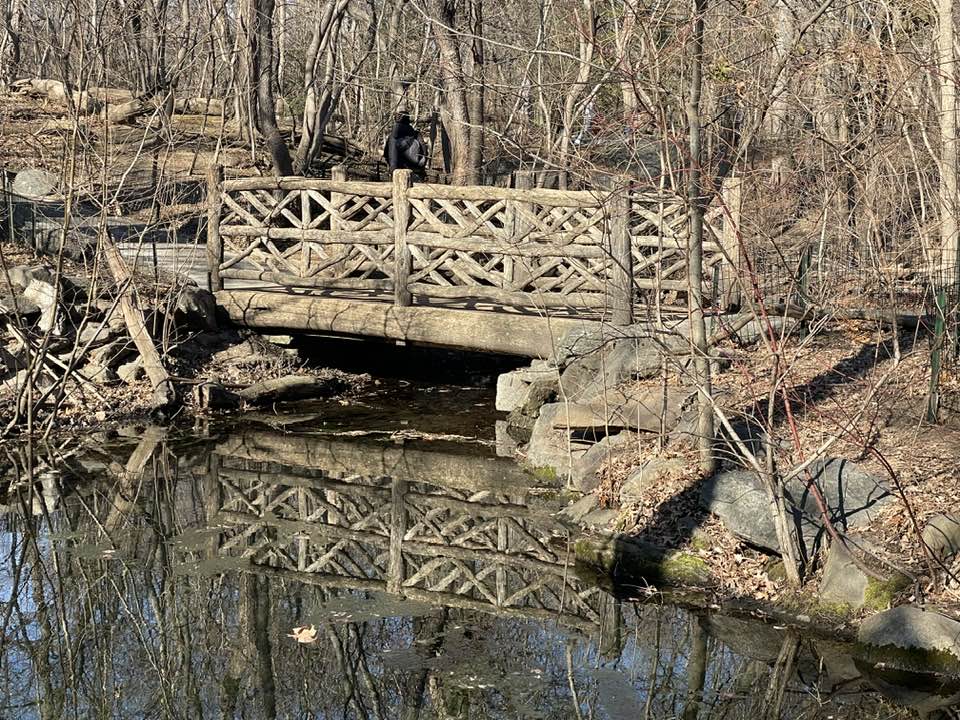MARCH 3, 2025 – Today with my sister as a guide, I took another long walking tour of Central Park, winding up at the Metropolitan Museum of Art. There we spent over an hour viewing the special exhibit of works by Caspar David Friedrich, the German Romantic landscapist. Given the Romantic inspiration derived from nature, the walking tour of the park served as an excellent prelude to viewing and absorbing Friedrich’s masterpieces.
Jenny is an enthusiastic ambassador of the 843-acre park, which was created in 1858 and designed by the famous landscape architects, Frederick Law Olmsted and Calvert Vaux. It boasts 42 million visits a year, and is, well, one of the central attractions of New York City. Every day Jenny hikes at a racing pace up and down and all around the park and has become intimately familiar with its countless features and winding walking paths. She has turned me into a convert. Whenever I visit New York, I gravitate not to the food, the plays, the music, the museums, but to Central Park. How ironic that I should prefer to hike in nature’s preserve when I’m in the biggest, most exciting city in America!
But the park is truly a work of art . . . nature manipulated by human imagination inspired by the infinite wonders of creation. The ubiquitous outcroppings of ancient Manhattan schist; trees emulating Shiva with multiple limbs the size of trunks twisting in in all directions; daffodil greens and flowering snow-drops signaling spring just over the horizon; paths twisting up and down and all around The Ramble; a loud chorus of sparrows hidden from sight inside a gargantuan shrub; a holly tree as high as a two-story house; singing brooks spilling their waters over boulders; many more trees—18,000 of them, to be precise—of countless varieties. In many sections along our way, we hiked as if through a painting of a bucolic early 19th century landscape . . .
. . . which is exactly where we found ourselves inside the Friedrich exhibit at the Met. Wholly unacquainted with this master beforehand, I was much better informed after observing his works. Understandably, the exhibit drew lots of visitors, and we had to summon a degree of patience to wait our turn before we could obtain a full view of many of the paintings. As I surveyed the diversity of the crowd in age, language, and apparent background, however, I found renewed faith in inhumanity. Here in the year 2025, we of disparate origins were edging along together, enthralled by the artistic insights of a late 18th century, early 19th century German painter.
I was touched by his command of light—especially moonlight—his unusual highlighting of foreground promontories versus distant elevations, his treatment of man as wanderer. I was also moved by his words:
The artist’s task is not the faithful representation of air, water, rocks, and trees, but rather his soul, his sensations should be represented in them. The task of a work of art is to recognize the spirit of nature, and with one’s whole heart and intention, to saturate oneself with it and absorb it and give it back again in the form of a picture.
Friedrich’s philosophy of painting soon fell out of vogue, as the 19th century progressed. But time and perspective have a way of breathing new life into old works.
After exiting the Met, we headed north beyond the Reservoir, admiring the many “trophy trees” spreading their huge limbs horizontally like benches in the air reserved for invisible titans. Soon spring will arrive, obscuring in leafy garments so much that is now exposed. By then the dogs will have shed their sweaters and booties; their masters—wool hats and down jackets. Returning migratory birds will bring a new chorus, and nature’s rebirth and new spirit will fill this park, Central Park, one of America’s urban gems, every bit as impressive as Gotham’s tallest monuments of glass and steel.
Subscribe to this blog and receive notifications of new posts by email.
© 2025 by Eric Nilsson

1 Comment
I’m anxious to see the Friedrich exhibit myself. You reminded me that I’ve done two posts about works of his on my own blog.